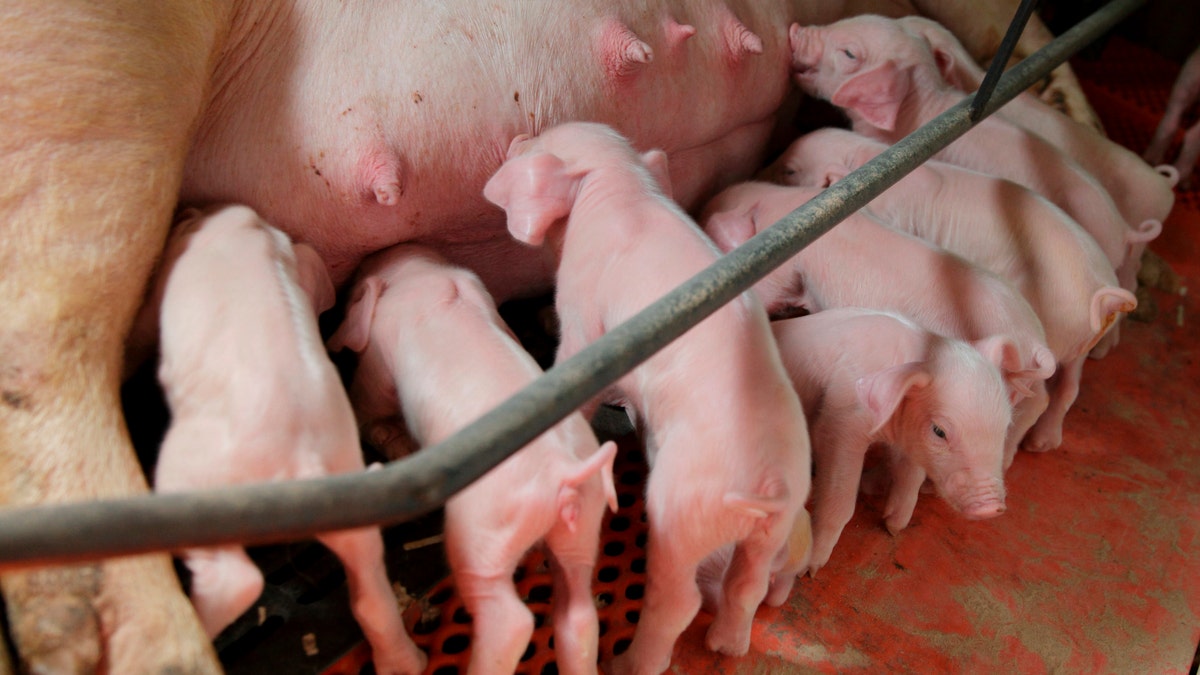
Newborn piglets suckle at Whiteshire Hamroc farm in Albion, Indiana March 16, 2012. The animals here at the Whiteshire Hamroc farm have been bred for one purpose: to be flown halfway around the world, on a journey fueled by China's appetite for food independence. In a country where pork is a culinary staple, the demand for a protein-rich diet is growing faster than Chinese farmers can keep up. While Americans cut back on meat consumption to the lowest levels seen in two decades, the Chinese now eat nearly 10 percent more meat than they did five years ago. Picture taken March 16, 2012. To match INSIGHT USA-CHINA/FOOD REUTERS/John Gress (UNITED STATES - Tags: FOOD AGRICULTURE BUSINESS ANIMALS) - RTR30Z07 (REUTERS/John Gress)
Mexico said on Tuesday it has restricted imports of live hogs from the United States because of the deadly piglet virus that has spread north of the border.
Imports of U.S. hogs would be reviewed on a case by case basis, said Mexico's Agriculture Ministry, which also said the virus has not been detected in Mexico.
The action does not affect shipments of U.S. pork to Mexico, it only affects live animals, U.S. officials said on Tuesday.
"The Agriculture Ministry has taken several measures to protect the Mexican pork-rearing industry and to prevent this illness from entering the country," the Ministry said.
It added that pigs that had been imported from the United States prior to May 17 would be quarantined and closely observed. It is checking all lots of U.S. pigs imported in the past three months.
According to USDA data, the United States exported 26,793 live hogs to Mexico in 2012, a 206 percent increase from a year earlier. This year, U.S. livestock producers exported 3,758 hogs to Mexico in the first four months, down 34 percent from a year earlier.
Mexican economy ministry data shows Mexico imported 28,624 pure-breed hogs from the United States in 2012, worth $8.65 million.
Porcine Epidemic Diarrhea Virus (PEDV), a swine virus deadly to young pigs, and never before seen in North America, has spiked to 199 sites in 13 states in the United States.
Most often fatal to very young pigs, the virus causes diarrhea, vomiting and dehydration. It also sickens older hogs, though their survival rate tends to be high.
However, the virus does not pose a health risk to humans or other animals and the meat from infected pigs is safe for people to eat, according to federal officials in the United States and livestock economists.
U.S. livestock exporters learned of the restrictions last week after Mexico notified the USDA's Animal and Plant Health Inspection Service it was changing its regulations over the import of U.S. swine, said Tony Clayton, president of the Livestock Exporters Association of the USA.
Now, U.S. hog producers will need a permit issued by Mexico in order to export live swine into the country, as there are no longer any regulatory guidelines for them to follow. However, no U.S. exporter has yet been denied a permit, Clayton said.
"Any time we lose a market, we are concerned," he said.
VIRUS SPREADING IN U.S.
The pig virus is spreading rapidly across the United States and is proving harder to control than previously believed.
Swine veterinarians, investigators with the U.S. Agriculture Department and others are trying to determine how the virus is spreading from farm to farm and state to state. Currently the focus is on the nation's livestock transportation system.
PEDV is spread most commonly by pigs ingesting contaminated feces. Investigators are studying physical transmission, such as truck trailers marred with contaminated feces, or a person wearing dirty boots or with dirty nails.
While the virus has not tended to kill older pigs, mortality among very young pigs infected in U.S. farms is commonly 50 percent, and can be as high at 100 percent, say veterinarians and scientists who are studying the outbreak.
The strain of the PEDV virus that is making its way across the nation's hog farms and slaughterhouses is 99.4 percent similar in genetic structure to the PEDV that hit China's herds last year, according to the U.S. researchers.
After PEDV was first diagnosed in China in 2010, it overran southern China and killed more than 1 million piglets, according to the Centers for Disease Control and Prevention's Emerging Infectious Diseases Journal.
No direct connection has been found between the U.S. outbreak and previously identified outbreaks in Asia and Europe, say scientists and researchers.
The value of total U.S. exports of live swine, which are typically exported for breeding and improved genetics, was about $32.3 million in 2012, according to the U.S. Department of Agriculture's Foreign Agricultural Service.
China has been the biggest importer of such live breeding swine, buying around $17.1 million worth, followed by Mexico and Russia.
The demand for such live animals, whether young hogs or baby chicks, is part of a bid by emerging markets to snap up millions of live animals raised by U.S. farmers as breeding stock - and capitalize on decades of cutting edge agricultural research in America.
